FDPS-Influenced Transcriptome Alternations in MC3T3-E1 Cells are Associated with the Pathogenesis of Osteoporosis
IF 0.9
4区 材料科学
引用次数: 0
Abstract
Regulatory factors function by modulating a variety of cascade mechanisims in cells. FDPS is a potential RNA-Binding Protein involved in various biological functions such as transcription, post-transcriptional processing, translation and post-translational modification. FDPS promote post-translational modification of GTPase for the treatment of diseases associated with bone resorption. However, it is not clear whether FDPS plays an information-regulating role through the action of splicing factors. In this study, the cell biology, gene expression profile and alternative splicing pattern of FDPS-overexpressed MC3T3-E1 cells (FDPS-OE) were compared with the control. The results showed that FDPS-OE promoted cell proliferation and inhibited cell apoptosis, and identified the potential target genes and potential functions of FDPS. In addition, FDPS-OE extensively regulated the transcriptional levels of cellular immune response and glycometabolism-related genes, thus affecting the immune function of bone formation and glycometabolism of bone cells. Finally, FDPS extensively regulates the selective splicing of hundreds of genes, and has functions of regulating cell cycle, cell division and positive transcription. The splicing of these genes regulated by FDPS plays an important role in cell proliferation and apoptosis and gene transcription regulation. In conclusion, FDPS can mediate the formation and apoptosis of abnormal osteoblasts through splicing regulation, thus causing the occurrence and development of osteoporosis.fdps影响的MC3T3-E1细胞转录组改变与骨质疏松的发病机制有关
调节因子通过调节细胞中的多种级联机制发挥作用。FDPS是一种潜在的rna结合蛋白,参与转录、转录后加工、翻译和翻译后修饰等多种生物学功能。FDPS促进GTPase的翻译后修饰,用于治疗与骨吸收相关的疾病。然而,FDPS是否通过剪接因子的作用发挥信息调控作用尚不清楚。本研究比较了过表达fdps的MC3T3-E1细胞(FDPS-OE)的细胞生物学、基因表达谱和可选剪接模式。结果表明,FDPS- oe具有促进细胞增殖和抑制细胞凋亡的作用,并鉴定了FDPS的潜在靶基因和潜在功能。此外,FDPS-OE广泛调控细胞免疫应答和糖代谢相关基因的转录水平,从而影响骨形成和骨细胞糖代谢的免疫功能。最后,FDPS广泛调控数百种基因的选择性剪接,具有调节细胞周期、细胞分裂和正转录的功能。FDPS调控的这些基因的剪接在细胞增殖、凋亡和基因转录调控中起着重要作用。综上所述,FDPS可以通过剪接调节异常成骨细胞的形成和凋亡,从而导致骨质疏松的发生发展。
本文章由计算机程序翻译,如有差异,请以英文原文为准。
求助全文
约1分钟内获得全文
求助全文
来源期刊

Science of Advanced Materials
NANOSCIENCE & NANOTECHNOLOGY-MATERIALS SCIENCE, MULTIDISCIPLINARY
自引率
11.10%
发文量
98
审稿时长
4.4 months
 求助内容:
求助内容: 应助结果提醒方式:
应助结果提醒方式:


